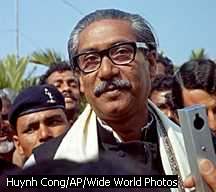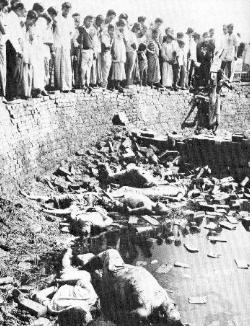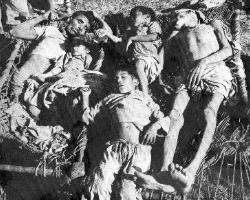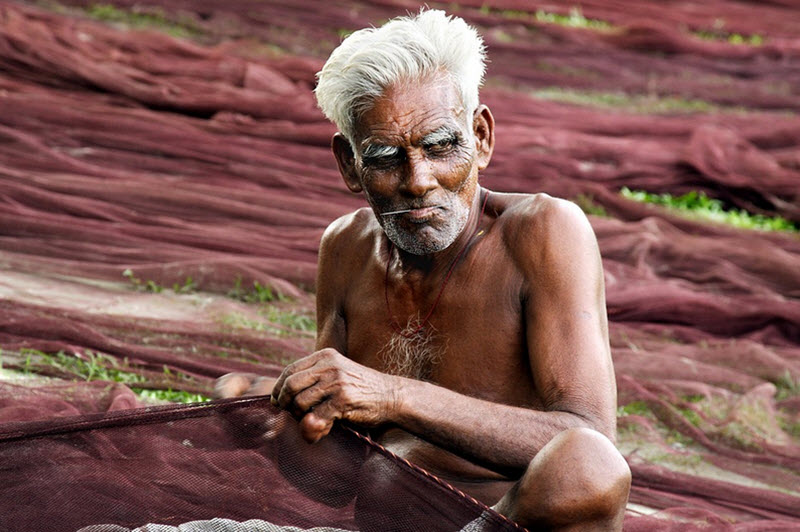Brief summary
Bangladesh did declare itself a sovereign state until April 10, 1971. Prior to this, it was still a part of Pakistan, was referred to as East Pakistan, and was embroiled in a struggle against oppression and discrimination carried out by the military regime of Pakistan (seated in West Pakistan).
In an attempt to deflate the East Pakistan (Bangladesh) independence movement, the West Pakistan military regime launched a massive campaign of killing people in East Pakistan to scare the remaining population into submission. The campaign started in March 1971 and continued well into December that same year. It only stopped because of Indian military intervention against the West Pakistan military forces in Bangladesh.
Understanding the background
After reaching independence from British colonialism in the 1940s, long-held frictions along ethnic and religious lines became very apparent on the Indian subcontinent.

The Indian leader Mahatma Gandhi struggled to keep the nation together, but in vain, as strong forces were working for the creation of two states: a Hindu-dominated and a Muslim-dominated. In 1947, these plans became reality and India was partitioned into two sovereign states; the Hindu-dominated India and the Muslim-dominated Pakistan. In fear or religious persecution and sectarian violence, many Hindus fled from Pakistan to India and vice versa.
The arrangement proved to be unstable and three major wars were fought between India and Pakistan soon thereafter. Kashmir – divided by a ceasefire line in 1947 – became a hot spot for prolonged conflicts, and in 1998-1999, a fourth full-scale war looked to be war imminent, but was eventually thwarted.
Among all this Pakistan was struggling with the fact that it consisted of two separate territories, divided from each other by hundreds of miles of Indian territory. These territories were West Pakistan and East Pakistan. To further complicate the situation, these two territories were not divided only by geography but also by ethnic identification.
In 1958, the road toward functional democracy in Pakistan was blocked as the country turned into a military dictatorship. After this, the relationship between West Pakistan and East Pakistan deteriorated further, and a colonial situation emerged where most of the power was held by West Pakistan who used it to dominate the Bengali population of East Pakistan.
The Awami League
In August, 1970, push came to a show as catastrophic floods struck East Pakistan, and West Pakistan was widely seen as not responding with enough dedication and resources to help those in need. This apparent neglect helped fuel the popularity of the independence-seeking Awami League, led by Sheikh Mujibur Rahman.
In national elections held in December 1970, the Awami League won an overwhelming victory across Bengali territory. They were running on a platform that demanded autonomy for East Pakistan and an end to military rule.
The February 1971 decision
The generals in power in West Pakistan did not take kindly to the result of the 1970 December election, and on February 22, 1971, they took a decision to crush the Awami League and its supporters.
According to Robert Payne´s 1972 book “Massacre”, the generals´s plan was to kill enough people to scare the rest into submission.
“Kill three million of them,” said President Yahya Khan at the February conference, “and the rest will eat out of our hands.” (Robert Payne, Massacre [1972], p. 50.)
March 1971 – The plan is put into action
 West Pakistan´s planned genocide campaign was put into action on March 25, 1971. A university in Dacca was attacked and hundreds of students killed. Soon, the violence spread to the rest of town, as military death squads began roaming the streets. According to Payne, circa 7,000 people were killed in a single night.
West Pakistan´s planned genocide campaign was put into action on March 25, 1971. A university in Dacca was attacked and hundreds of students killed. Soon, the violence spread to the rest of town, as military death squads began roaming the streets. According to Payne, circa 7,000 people were killed in a single night.
“Within a week, half the population of Dacca had fled, and at least 30,000 people had been killed. Chittagong, too, had lost half its population. All over East Pakistan people were taking flight, and it was estimated that in April some thirty million people [!] were wandering helplessly across East Pakistan to escape the grasp of the military.” (Robert Payne, Massacre [1972], p. 48.)
At the outbreak of the genocide plan in March 1971, East Pakistan was home to roughly 75 million people. Soon, approximately 10 million of them had made their way to India, where the country was overwhelmed by the huge influx of refugees in need. This situation spurred Indian military intervention.
April 1971 – Bangladesh declares independence and fights back
On April 10, 1971, the Awami League declared East Pakistan to be an independent state with the name Bangladesh.
After the independence declaration, Bangladesh forces (known as Muktha Bahini) began to fight back the West Pakistani military forces. Even though they had less resources than their opponent, they had the classic guerilla advantages of knowing the terrain and being supported by local civilian populations. Soon, they had cleared vast areas of Bangladesh from West Pakistani forces.
The gendercide against Bengali men
According to Anthony Mascarenhas 1972 book “The Rape of Bangla Desh”, West Pakistan responded to the advances of Muktha Bahini in classical gendercidal fashion.

The book lists how the targets were:
- The Bengali militarymen of the East Bengal Regiment, the East Pakistan Rifles, police and para-military Ansars and Mujahids.
- Hindus in general, but only men, not women and children.
- Students; college and university boys, and some of the more militant girls
- Bengali intellectuals such as professors and teachers if considered (by the army) to be militant.“We are only killing the men; the women and children go free. We are soldiers not cowards to kill them …” I was to hear in Comilla [site of a major military base] [Comments R.J. Rummel: “One would think that murdering an unarmed man was a heroic act” (Death By Government, p. 323)] (3) The Awami Leaguers — all office bearers and volunteers down to the lowest link in the chain of command. – Anthony Mascarenhas, The Rape of Bangla Desh [Delhi: Vikas Publications, 1972], pp. 116-17.
Mascarenhas does note that even though targeted professionals like soldiers, intellectuals, professors, teachers, and office bearers in this context could be expected to be mostly (albeit not exclusively) men, there were many cases where their family members died alongside them regardless of gender.
Age
In “Centuries of Genocide” by Totten et al., Rounag Jahan writes in his essay “Genocide in Bangladesh” that young men and adolescent boys where targets fore arrests, torture and killings regardless of social class.
“All through the liberation war, able-bodied young men were suspected of being actual or potential freedom fighters. Thousands were arrested, tortured, and killed. Eventually cities and towns became bereft of young males who either took refuge in India or joined the liberation war.” – Quote from the essay “Genocide in Bangladesh” by Rounag Jahan, found on page 298 in the book “Centuries of Genocide” edited by Totten et al.
Jahan also notes that it was especially during the first phase of the genocide that young able-bodied males were the targets of killings regardless of class or political affiliations.
In his book “Death By Government”, R.J. Rummel brings forth a similar view, saying that “the Pakistan army [sought] out those especially likely to join the resistance — young boys. Sweeps were conducted of young men who were never seen again. Bodies of youths would be found in fields, floating down rivers, or near army camps. As can be imagined, this terrorized all young men and their families within reach of the army. Most between the ages of fifteen and twenty-five began to flee from one village to another and toward India. Many of those reluctant to leave their homes were forced to flee by mothers and sisters concerned for their safety.” – R.J Rummel, “Death By Government”, p. 329.)
On page 323 in the same book as quoted above, Rummel notes how circumcision was used by the army to single out who should live and who should die. “In what became province-wide acts of genocide, Hindus were sought out and killed on the spot. As a matter of course, soldiers would check males for the obligated circumcision among Moslems. If circumcised, they might live; if not, sure death.”
The mass-killings at the Pakistan National Oil Company warehouse in Hariharpara
One chilling and detailed description of how mass-killings were carried out during the Bangladesh genocide can be found in Robert Payne´s work “Massacre”. In his book, Payne describes exterminations near Dacca that were not explicitly gender-selected, but still interesting to bring up here in this context since they provide some insight to how the West Pakistani military managed to carry out such a large number of killings of non-combatants during their campaign.
At the village Hariharpara near Dacca, the military found a good combination of factors: A facility that could hold a large number of people, where there was a suitable place for mass executions, and from which the bodies could be disposed of without much effort.
That facility was a large warehouse belonging to the Pakistan National Oil Company, conveniently located at the edge of the River Buriganga. The intended victims where held captive in the warehouse until night, when they were taken to the river. Typically, they were roped together in batches of six or eight, and forced to wade out into the river. From a pier, the executioners would then shoot them, and the bodies collapse into the water. A new bunch of prisoners would be brought out, and the procedure would be repeated. In the morning, the village boatmen would haul dead bodies into the midstream part of the river, and also cut the ropes to allow each body to drift downstream on its own.
Source: Rober Payne, “Massacre” [Macmillan, 1973], p. 55.
Attacks on women
When we talk about the gendercide in Bangladesh, do we imply that the women were spared? No, we do not, only that they were treated somewhat differently and were largely targeted for gender-selected atrocities, including rape and rape-murder combinations. In Europe and North America, the atrocities in Bangladesh even became known as The Rape of Bangladesh, due to the systematic sexual assaults on women.
What is interesting here is that while the West Pakistani military selectively killed Hindu men, sexual assault happened to Hindu women, Muslim women and Christian women as the Pakistani regulars swept through the terrain. According to Susan Brownmiller, approximately 80% of the raped women were actually Muslims, reflecting the population of Bangladesh at the time.
Source: Susan Brownmiller, “Against Our Will: Men, Women and Rape”, p. 81
Brownmiller reports that “200,000, 300,000 or possibly 400,000 women (three sets of statistics have been variously quoted) were raped”, and that all age groups were target, including girls.
“Girls of eight and grandmothers of seventy-five had been sexually assaulted … Pakistani soldiers had not only violated Bengali women on the spot; they abducted tens of hundreds and held them by force in their military barracks for nightly use.” – Brownmiller, p. 83
Women were subjected to gang rapes, and some individuals were raped as many as 80 times in a night. (Brownmiller, p. 83). Some died of their injuries, and some were killed afterwards.
After the nine-month long war, Prime Minister Mujibur Rahman declared the rape victims national heroines, but having them accepted by their own communities proved difficult, as they were considered unclean and unchaste. The government encouraged the Mukti Bahini men to marry unmarried and widowed rape victims, but few men were interested, and those who were typically expected the Bangladesh government to compensate them with substantial dowries. (Brownmiller, p. 84.)
Indian intervention puts an end to the Bangladesh genocide
On December 3, 1971, India – then led by Prime Minister Indira Gandhi – launched a full-scale military intervention against the Pakistani forces in Bangladesh. The Pakistani army soon collapsed, but not without mustering up the energy for one final outburst of genocidal activities. On December 16, the Pakistani military regime agreed to an unconditional surrender.
Awami leader Sheikh Mujib was released from captivity, and returned to Dacca on January 10, 1972. There, he established a parliament for an independent Bangladesh.
Revenge killings after the Bangladesh genocide
After the expulsion of the Pakistani military, a new wave of killings took place in Bangladesh – where those formerly oppressed sought revenge. Finding reliable numbers for this wave is difficult, but several estimations have landed around 150,000 killings.
Source: Rummel, “Death By Government”, p. 334
It should also be noted that political and military violence in Bangladesh did not end with the Bangladesh independence. On the contrary; the country has endured a string of military coups since then and a lot of politically motivated killings.
Who was in control during the Bangladesh genocide?
The genocide in Bangladesh was orchestrated by a group comprised of five Pakistani generals:
President Yahya Khan, General Tikka Khan, chief of staff General Pirzada, security chief General Umar Khan, and intelligence chief General Akbar Khan.
Several organizations have lobbied to bring them before an international tribunal, but this has yet not happened.
U.S. government involvement
The U.S. government was a strong supporter of the military regime in Pakistan. Even after the onset of the genocide, they continued their support and provided the regime with military equipment worth an estimated 3.8 million USD. The help continued even after a government spokesman had told Congress that all shipments to Yahya Khan´s regime had stopped.
Source: Payne, “Massacre”, p. 102
Death toll for the Bangladesh genocide
Finding reliable numbers regarding the Bangladesh genocide has proven to be difficult, especially if one wants to separate combatant deaths from non-combatant deaths. It is also not possible to ascertain with any security the proportion of men versus women killed.
Rummel´s “Death By Government” does provide us with some numbers for a limited period of only 267 days. From the eighteen districts, 1,247,000 were reported killed by the West Pakistan military during that time period.
All in all, the number of Bangladesh people killed by the Pakistani army and its allied groups throughout the war is estimated by various sources to be in the seven figures, ranging from 1,000,000 to 3,000,000.
It should be noted that the Pakistani military regime and its allied paramilitary groups killed a very high number of people in both West Pakistan and East Pakistani/Bangladesh, but the rate of killings was notably higher in the latter region. From March 1969 to December 1971, the military regime killed 1 out of 60 people in Pakistan overall and 1 out of every 25 Bengalis, Hindus, and others in East Pakistan/Bangladesh. That makes the annual killing rate for this regime higher than the one for the Soviet Union and communist China.
Source: Rummel, “Death By Government”, p. 331.

Forex trading in the UK
Forex trading refers to trading on the Foreign exchange market. On the Foreign exchange market or Forex market, different currencies are bought and sold. The traders buy one currency and pay with another currency. The trading on the forex market determines the exchange rate you receive when you exchange currency before going abroad. The forex market is very important for international trade as it allows buyers and sellers in different countries to trade with each other. The currency market was previously only open to banks and large institutions but it is now open to retail investors who want to trade on the market. Forex trading is often margin trading and can ve very high risk. It can be very lucrative if you are a skilled trader but most traders end up losing money. The first step to becoming a skilled trader is to choose one of the best UK forex trading platforms (brokers) and to use the demo account the forex trading platform provides you with to make virtual trades until you are skilled enough to make money on the forex market. Starting trading using real money is the number 1 error made by people who start forex trading. Make sure to have patience and only start trading when you know you are skilled enough to make money from the trade.
